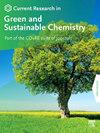晶体防御者:银纳米粒子作为抗菌战争的新前线
Q2 Materials Science
Current Research in Green and Sustainable Chemistry
Pub Date : 2025-01-01
DOI:10.1016/j.crgsc.2025.100481
引用次数: 0
摘要
纳米技术领域正在引起越来越多学者的关注。药用植物中生物活性化合物的存在使其成为纳米颗粒合成的绝佳选择。本文详细介绍了一种简单、环保的绿色合成技术制备结晶银纳米粒子(AgNPs)。以红豆杉植物提取物为还原剂合成纳米颗粒。采用x射线衍射(XRD)、紫外可见光谱(UV-Visible spectroscopy)、傅里叶变换红外光谱(FTIR)、场发射扫描电镜(FESEM)等多种分析方法对合成颗粒的尺寸和结构进行了研究。合成的AgNPs在425 nm处有明显的吸收峰。AgNPs的FTIR光谱在300-4000 cm−1区域具有多个光谱带。XRD分析证实了银纳米颗粒的成功形成,合成的样品在2θ值37.09°,43.29°,65.32°和76.40°处有明显的衍射峰。生物合成的AgNPs在纳米尺度上形成球形聚集体,FESEM显示其粒径约为60 ~ 80 nm。它们被发现对多种真菌病原体有效,如黑曲霉、烟曲霉、尖孢镰刀菌和扩张青霉,以及包括金黄色葡萄球菌、大肠杆菌、普通变形杆菌和肺炎克雷伯菌在内的细菌菌株。纳米颗粒在不同浓度下表现出不同直径的抑制带,制霉菌素和卡那霉素分别作为真菌和细菌的阳性对照。最高剂量(0.4 mg/ml)对扩张青霉的抑制区最大(18.42±0.43 mm),最低剂量(0.2 mg/ml)对黑曲霉的抑制区最小(10.18±0.13 mm)。对细菌,最高剂量(2.5 mg/ml)对肺炎克雷伯菌的抑制带最大(12.78±0.17 mm),最低剂量(1.9 mg/ml)对寻常变形杆菌的抑制带最小(8.85±0.25 mm)。研究表明,合成的纳米颗粒对真菌的抑制作用大于对细菌的抑制作用。该研究证明,绿色合成的AgNPs从红豆杉叶提取物可以有效地对抗多种病原体。本文章由计算机程序翻译,如有差异,请以英文原文为准。
Crystalline defenders: Silver nanoparticles as a new front in antimicrobial warfare
The field of nanotechnology is capturing the attention of more and more researchers in their scholarly investigations. The presence of biologically active compounds in medicinal plants makes them an excellent choice for the synthesis of nanoparticles. This paper details the formation of crystalline silver nanoparticles (AgNPs) using a simple and environmentally friendly green synthesis technique. The nanoparticles were synthesized using plant extract of Taxus wallichiana as the reducing agent. Various analytical methods, including X-Ray Diffraction (XRD), UV–Visible spectroscopy, Fourier Transform Infrared Spectroscopy (FTIR), and Field Emission Scanning Electron Microscopy (FESEM), were employed to investigate the size and structure of the synthesized particles. The as-synthesized AgNPs exhibited a prominent absorption peak at 425 nm. The FTIR spectrum of the AgNPs featured multiple spectral bands across the 300–4000 cm−1 region. XRD analysis confirmed the successful formation of silver nanoparticles, with the synthesized sample exhibiting distinct diffraction peaks at 2θ values of 37.09°, 43.29°, 65.32°, and 76.40°. The biosynthesized AgNPs formed spherical aggregates at the nanoscale, with particle diameters ranging from approximately 60 to 80 nm as revealed by FESEM. They were found to be effective against a variety of fungal pathogens, such as Aspergillus niger, A. fumigatus, Fusarium oxysporum, and Penicillium expansum, as well as bacterial strains including Staphylococcus aureus, Escherichia coli, Proteus vulgaris, and Klebsiella pneumoniae. The nanoparticles demonstrated inhibition zones of varying diameters at different concentrations, with Nystatin and Kanamycin serving as positive controls for the fungal and bacterial species, respectively. The largest inhibition zone (18.42 ± 0.43 mm) was observed at the highest dose (0.4 mg/ml) for Penicillium expansum, while the smallest (10.18 ± 0.13 mm) was noted at the lowest dose (0.2 mg/ml) for Aspergillus niger. For bacteria, the highest dose (2.5 mg/ml) produced the largest inhibition zone (12.78 ± 0.17 mm) in Klebsiella pneumoniae, while the lowest dose (l.9 mg/ml) led to the smallest inhibition zone (8.85 ± 0.25 mm) in Proteus vulgaris. The study revealed that the synthesized nanoparticles showed greater inhibition against fungal species than against bacterial species. This study provides evidence that green-synthesized AgNPs from the leaf extract of Taxus wallichiana can be effective against a wide range of pathogen species.
求助全文
通过发布文献求助,成功后即可免费获取论文全文。
去求助
来源期刊

Current Research in Green and Sustainable Chemistry
Materials Science-Materials Chemistry
CiteScore
11.20
自引率
0.00%
发文量
116
审稿时长
78 days
 求助内容:
求助内容: 应助结果提醒方式:
应助结果提醒方式:


